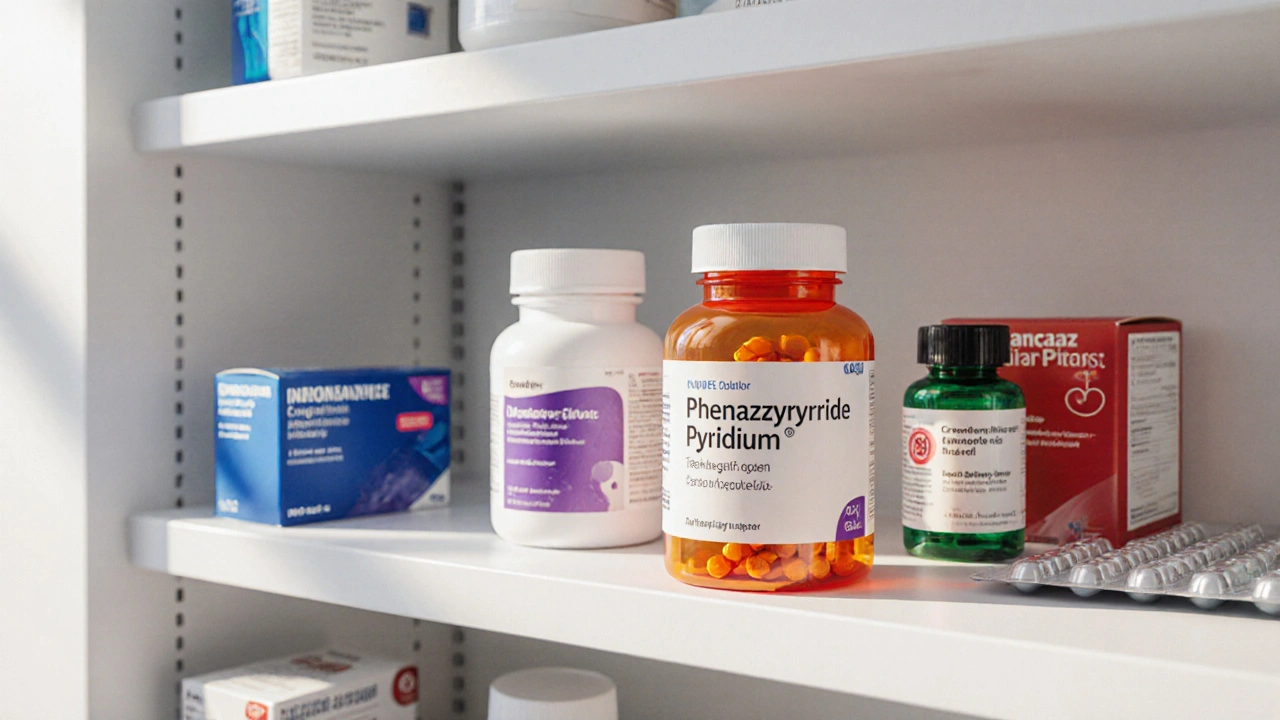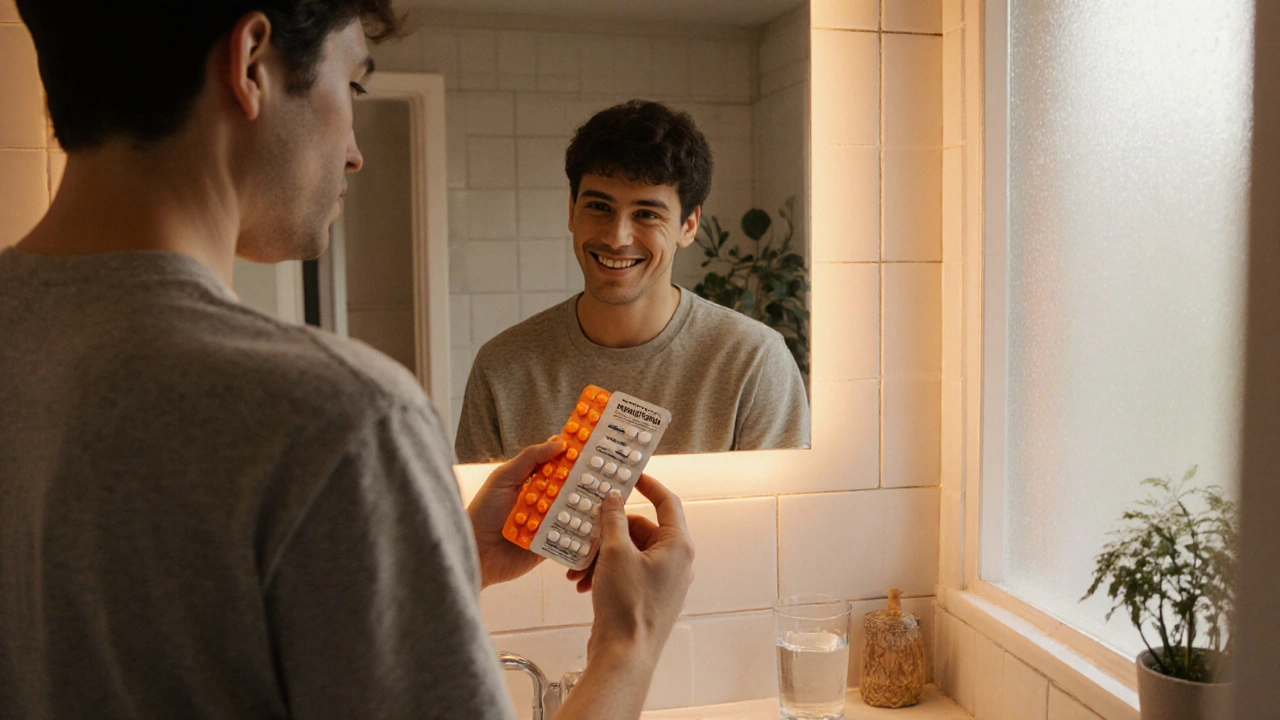
Urinary Pain Relief Selector
If you’re weighing Phenazopyridine against other options for painful urination, you’re not alone. Millions of Australians face the uncomfortable sting of a urinary tract infection (UTI) each year, and the over‑the‑counter market is crowded with pills, powders, and herbs promising quick relief. This guide breaks down how Pyridium works, what you can expect, and how it stacks up against the most popular alternatives on the shelf.
Quick Takeaways
- Phenazopyridine provides fast, localized pain relief but does not treat the infection itself.
- NSAIDs (e.g., ibuprofen) reduce inflammation and pain system‑wide, useful when fever accompanies a UTI.
- Acetaminophen eases mild pain without stomach irritation, but offers no anti‑inflammatory benefit.
- Herbal options such as cranberry extract and D‑mannose aim to prevent bacteria from sticking to the bladder wall, not to relieve existing pain.
- Prescription antibiotics remain the only cure for bacterial UTIs; analgesics are only adjuncts.
What is Phenazopyridine?
Phenazopyridine is a synthetic azo dye that acts as a urinary tract analgesic. It works by numbing the lining of the urinary tract, which dulls the burning sensation caused by irritation.
The drug is sold under the brand name Pyridium and also appears in generic forms such as Azo Urinary Pain Relief and Urogesic. Each tablet typically contains 100mg of Phenazopyridine.
Because it is excreted unchanged in the urine, the medication colors urine orange‑red - a harmless but noticeable side effect that warns you the drug is working.
How Phenazopyridine Works
The analgesic effect kicks in within 30‑60minutes and can last up to three hours. It does not have antibacterial or anti‑inflammatory properties, so it should only be used for short‑term symptom control while a doctor treats the underlying infection.
Typical OTC dosing is one tablet three times a day for no more than two days unless a healthcare professional advises otherwise. Prolonged use can mask worsening symptoms and increase the risk of complications.

When to Reach for Phenazopyridine
Ideal scenarios include:
- Acute cystitis with burning or urgency but no fever.
- Post‑operative urinary discomfort after minor urologic procedures.
- Short‑term relief while awaiting a doctor’s appointment.
Not suitable for:
- Kidney stones larger than 5mm, where stronger pain management is needed.
- Patients with G6PD deficiency, as the drug can trigger hemolysis.
- Pregnant or breastfeeding women unless prescribed.
Alternative Options Overview
Below are the most common alternatives you’ll encounter in Australian pharmacies and supermarkets.
- Ibuprofen - a non‑steroidal anti‑inflammatory drug (NSAID) that reduces pain and inflammation throughout the body.
- Acetaminophen - an analgesic that eases mild pain without affecting the stomach lining.
- Cranberry Extract - a plant‑based supplement believed to prevent bacterial adhesion in the urinary tract.
- D‑Mannose - a simple sugar that interferes with the ability of E.coli to stick to bladder walls.
- Nitrofurantoin - a prescription antibiotic that treats bacterial UTIs.
Side‑by‑Side Comparison
| Attribute | Phenazopyridine (Pyridium) | Ibuprofen | Acetaminophen | Cranberry Extract | D‑Mannose | Nitrofurantoin |
|---|---|---|---|---|---|---|
| Primary Action | Local urinary analgesic | Systemic NSAID (anti‑inflammatory) | Systemic analgesic | Prevents bacterial adhesion | Blocks bacterial adhesion | Antibacterial (prescription) |
| Onset of Relief | 30-60min | 45-90min | 30-60min | Several days (preventive) | Several days (preventive) | 24-48h (after dosing) |
| Duration per Dose | 2-3h | 4-6h | 4-6h | Continuous use | Continuous use | Full course (3‑7days) |
| Typical OTC Dose | 100mg 1‑3×/day (max 2days) | 200‑400mg 1‑3×/day | 500‑1000mg 1‑3×/day | 500‑1500mg daily | 500‑1000mg daily | Prescribed 50‑100mg 4×/day |
| OTC/Prescription | OTC (short‑term) | OTC | OTC | OTC supplement | OTC supplement | Prescription only |
| Common Side Effects | Orange urine, headache, GI upset | Stomach irritation, increased bleed risk | Liver toxicity (high dose), rash | Stomach upset, possible kidney stones | Rare GI upset | Nausea, allergic rash, liver impact |
| Average Cost (AU$ per month) | ~$12 for 30 tablets | ~$15 for 30 tablets | ~$10 for 30 tablets | ~$20 for 60 capsules | ~$18 for 60 capsules | ~$35 for 14‑day pack (with script) |

Choosing the Right Option for You
Consider these decision points before reaching for the next bottle:
- Root cause: If a doctor confirmed a bacterial UTI, antibiotics are non‑negotiable. Analgesics only mask symptoms.
- Symptom severity: A mild burning sensation can be soothed quickly with Phenazopyridine. Moderate pain with fever may need ibuprofen for systemic relief.
- Stomach sensitivity: Patients prone to gastric ulcers should avoid NSAIDs and may prefer Phenazopyridine or acetaminophen.
- Pregnancy status: Many clinicians recommend acetaminophen as the safest OTC pain reliever during pregnancy; Phenazopyridine is generally avoided.
- Preventive goal: If you’re looking to stop recurrent infections, D‑mannose or cranberry extract can be part of a long‑term strategy.
Always check with a pharmacist or doctor if you’re unsure. A short conversation can save weeks of discomfort.
Safety, Interactions, and Contra‑indications
Phenazopyridine should not be taken with:
- Other strong urinary dyes (may cause excessive discoloration).
- Kidney impairment that reduces drug clearance.
- G6PD deficiency - risk of hemolysis.
Ibuprofen interacts with blood thinners, certain blood pressure meds, and can worsen kidney function when dehydrated. Acetaminophen should never exceed 4g per day; chronic high doses damage the liver.
Herbal supplements are generally safe but can affect blood clotting when combined with warfarin (cranberry). D‑mannose is well tolerated, though high doses may cause loose stools.
Final Thoughts
There’s no one‑size‑fits‑all answer. Phenazopyridine excels at rapid, localized relief but does nothing to clear an infection. NSAIDs and acetaminophen broaden pain control at the cost of systemic effects. Herbal options play a preventive role, while antibiotics are the cure for bacterial UTIs. Matching your symptom profile, health history, and treatment timeline to the right product will get you back to feeling normal faster.
Frequently Asked Questions
Can I take Phenazopyridine with ibuprofen?
Yes, they can be combined because they work in different ways-Phenazopyridine numbs the urinary tract while ibuprofen reduces overall inflammation. However, limit ibuprofen to the lowest effective dose if you have stomach sensitivity.
Why does my urine turn orange after taking Pyridium?
The orange‑red color is a harmless side effect of the dye in Phenazopyridine. It indicates the drug is being excreted unchanged and is a visual cue that the medication is active.
Is Phenazopyridine safe for children?
The product is not recommended for children under 12years without medical supervision. Younger kids are more prone to dosage errors and side‑effects.
Can cranberry pills replace antibiotics for a UTI?
No. Cranberry extract may help prevent bacteria from adhering to the bladder wall, but it does not eradicate an existing infection. If a clinician has prescribed antibiotics, finish the full course.
How long can I safely use Phenazopyridine?
OTC guidelines advise a maximum of two days of use unless a doctor says otherwise. Longer use may mask worsening symptoms and increase the risk of side effects.
Is D‑Mannose effective for recurrent UTIs?
Clinical studies suggest D‑Mannose can reduce recurrence in women with E.coli‑driven UTIs, especially when taken daily after meals. It’s not a pain reliever, so you may still need an analgesic for acute symptoms.
What should I avoid while taking Phenazopyridine?
Avoid other strong urinary dyes, stay well‑hydrated, and do not exceed the recommended two‑day limit without a doctor’s go‑ahead. People with G6PD deficiency should skip it altogether.

 Health and Wellness
Health and Wellness
Rajesh Kumar Batham
October 12, 2025 AT 07:35Hey folks 😊, if you’re battling that burning feeling while waiting for the doc, Phenazopyridine can be a real lifesaver – it numbs the urinary tract in about half an hour and the orange‑tinted pee is a harmless reminder that it’s working. Just remember it’s only for short‑term use (max two days) and won’t clear the infection, so follow up with antibiotics. It’s also a good alternative if you have a sensitive stomach and can’t tolerate NSAIDs. Stay hydrated and don’t forget to check with a pharmacist if you’re pregnant or have G6PD deficiency. Hope this helps! 🚀
Bill Gallagher
October 26, 2025 AT 04:55While the comparative table presented in the article offers a concise snapshot, it is worthwhile to delve deeper into the pharmacodynamics of Phenazopyridine, especially when juxtaposed against systemic agents such as ibuprofen, which, unlike the localized analgesic action of Phenazopyridine, exerts its effect via cyclooxygenase inhibition, thereby attenuating prostaglandin synthesis across multiple organ systems; this distinction is not merely academic, it has practical ramifications for patients with comorbidities, for instance, those with peptic ulcer disease, who may experience exacerbated mucosal injury if NSAIDs are administered indiscriminately, a risk that Phenazopyridine circumvents by virtue of its renal excretion unchanged, resulting in minimal gastrointestinal exposure. Moreover, the onset of analgesia, cited as 30–60 minutes for Phenazopyridine, parallels that of acetaminophen, yet the duration of effect, often limited to two to three hours per dose, necessitates a more disciplined dosing schedule compared to the four‑to‑six‑hour window afforded by ibuprofen; this difference can influence patient adherence, particularly in populations prone to forgetfulness or irregular medication habits. It should also be emphasized that while Phenazopyridine is categorized as an OTC product, regulatory agencies across several jurisdictions, including the United States Food and Drug Administration, recommend a maximum duration of two days without medical supervision, a guideline that mirrors the precautionary principle applied to many symptomatic therapies. In contrast, ibuprofen, though also available OTC, carries a distinct set of contraindications, such as renal insufficiency and heightened bleeding risk when combined with anticoagulants, a nuance that clinicians must navigate when tailoring therapy. The safety profile of Phenazopyridine further warrants scrutiny; although the orange hue of urine is benign, the drug’s potential to precipitate hemolysis in individuals with glucose‑6‑phosphate dehydrogenase deficiency mandates prior screening in susceptible demographics, an aspect often overlooked in casual consumer use. Additionally, the metabolic fate of Phenazopyridine, which remains largely unchanged, reduces the likelihood of hepatic enzyme induction or inhibition, thereby sparing patients from drug–drug interactions that are commonplace with cytochrome P450 substrates. Finally, the cost analysis presented-approximately AU$12 for a thirty‑tablet supply-places Phenazopyridine in a competitive price bracket relative to ibuprofen (AU$15) and acetaminophen (AU$10), yet this superficial comparison omits the downstream financial implications of untreated infections, which can culminate in more expensive interventions, including hospitalizations. In sum, while Phenazopyridine excels at providing rapid, localized symptom relief, its utility is circumscribed by duration limits, contraindications, and the necessity of concomitant antimicrobial therapy to address the underlying infection, a balance that should guide both patients and prescribers in the decision‑making process.
Rajashree Varma
November 9, 2025 AT 02:15It’s wonderful to see a clear guide that puts the patient’s comfort first, especially when the pain of a urinary infection can be so distracting; the quick relief offered by Phenazopyridine can make the waiting period for antibiotics much more bearable, and the fact that it does not irritate the stomach makes it a thoughtful choice for those with sensitive digestion. Remember to stay hydrated and to seek professional advice if symptoms persist beyond a couple of days, as the underlying infection still needs proper treatment.
Anshuman Pandey
November 22, 2025 AT 23:35Consider the balance between immediate relief and long‑term healing; a short course of Phenazopyridine can ease the burning, yet it does not eradicate the cause, so pairing it with a plan for antibiotics honors both the body’s present comfort and its future health.
Thomas Malloy
December 6, 2025 AT 20:55Phenazopyridine works fast but only for a couple of days.